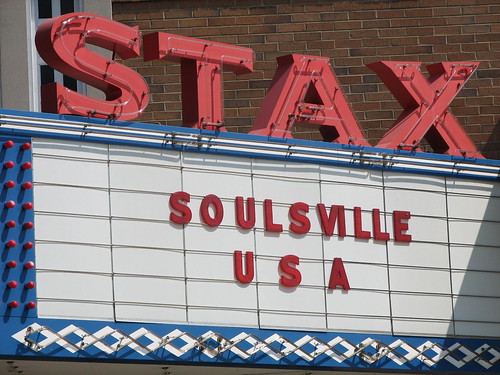
The recording studio was set up in 1957 in an old abondanded movie theatre and over the course of twenty years became the site of hundreds of famous soul recordings by Otis Redding, Isaac Hayes, the Bar-Kays, Booker T & the MGs and dozens more. It was eventually sold, then torn down in the 80s and today the exact location has been rebuilt and is now a museum for Stax Records. And they have tours.
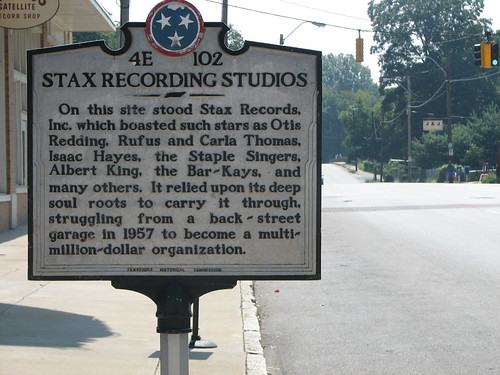


We arrived at the museum in time to start the 11:00 tour, which begins with a fifteen minute film about the history of Stax Records. We were the only ones in the small, make-shift theatre.
Having had our appetites whet, we started the self-guided tour at the beginning where there is a replica of an old southern church. This particular exhibit explains how gospel and blues are the origins for all the genres of music that began in the 40s and 50s. I was interested by the fact that gospel was explained as singing to the Lord in order to forget hardships, while blues is singing to another person (usually a loved one) about difficult times.
There were sections devoted to all the genres of music that influenced soul - Jazz, White Pop, R&B, Rock 'n' Roll as well as all the major influences from each of the genres. It was very interesting and laid the groundwork for the stories behind all of the Stax recording artists.
The next section displayed the history of Stax and explained how it was started by Jim Stewart and Estelle Axton (brother and sister) in 1957 on the corner of E McLemore Ave and College St.
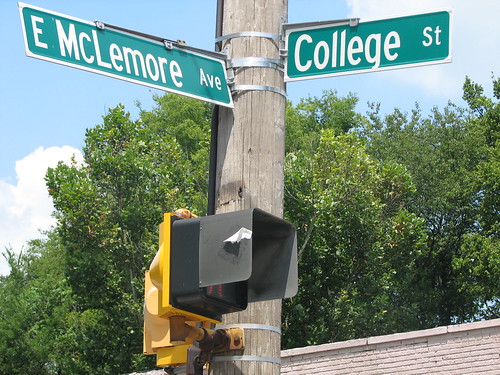
Jim handled the production and studio work, while Estelle looked after finances and promotion. The label was originally called Satellite Records (after a shop across the street) but was changed when they found out the name was already taken. They changed the name to Stax, which is the first two letters of each of their surnames.
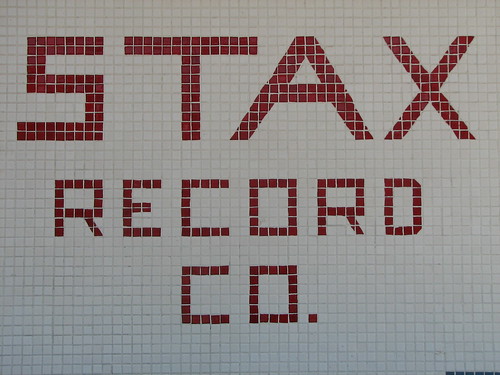
The shop across the street was run by Estelle and all the neighborhood kids, including members of the MGs, used to come by after school and listen to records. It was a relaxed atmosphere and served as a musical education in jazz, blues and country for all of the kids. The original building is still there today but does not seem to currently be in use.
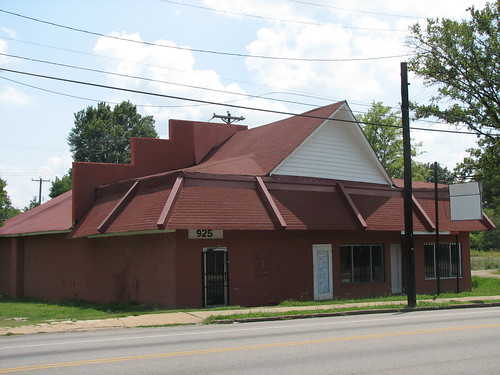
After the studio was set up, Rufus and Carla Thomas were the first recording for the label. A band comprised of high school students called the Mar-Keys recorded 'Last Night', which became the first nationally distributed hit.

Jim handled the production and studio work, while Estelle looked after finances and promotion. The label was originally called Satellite Records (after a shop across the street) but was changed when they found out the name was already taken. They changed the name to Stax, which is the first two letters of each of their surnames.

The shop across the street was run by Estelle and all the neighborhood kids, including members of the MGs, used to come by after school and listen to records. It was a relaxed atmosphere and served as a musical education in jazz, blues and country for all of the kids. The original building is still there today but does not seem to currently be in use.

After the studio was set up, Rufus and Carla Thomas were the first recording for the label. A band comprised of high school students called the Mar-Keys recorded 'Last Night', which became the first nationally distributed hit.
When the Mar-Keys broke up, some of the members became MGs and they along with Booker T were the house band for Stax and played on nearly every single recording of the 1960s for artists.The featured artists in the museum were Otis Redding, Sam & Dave, Carla Thomas, William Bell, Booker T & The MGs, The Bar-Kays and of course Isaac Hayes. Each section contained stage wardrobes and memorabilia for the artists. One of the coolest things was Isaac Haye's 1972 Cadillac El Dorado. It was peacock blue, had gold plated everything on the outside, a TV and refrigerator inside as well as floors covered entirely in white fur. The car was part of a contract that Hayes negotiated after the success of Shaft.
The story about the plane crash that killed Otis Redding and most of the Bar-Kays was of course very sad. The plane went down in December of 1967 when they were returning from a weekend of performances. It was a huge loss of talent for Stax and the loss of one of the nicest guys around as Redding was described.
One of my favourite stories was about the recording of Sam & Dave's hit 'Hold On, I'm Coming'. David Porter (Dave) wrote a lot of songs with Isaac Hayes and one night they were in the studio and really struggling with a particular song. David went to the house of wax when Hayes finally came up with the riff and yelled to David to hurry up. He replied by saying, "hold on, I'm coming" and ran back in to the studio with his pants at his knees. Apparently the song was born and written on the spot.
Stax was never very concerned with the latest technology and used very old, outdated equipment for nearly everything. All of the recordings were done with only one track machines. Since the studio was set up in an old cinema, the speaker that was already there was used for playback. Using all of these old equipment created a very distinct, unique sound for the label. Whereas Motown records were very over produced and aimed at making the charts, Stax records were very raw, unpolished and mainly concerned with capturing the intensity of the live music being played. Most of the original recording equipment used is in the museum along with an exact replica of the recording studio. Inside the studio are all of the instruments used by Booker T & The MGs for the recording of 'Green Onions'.
The story about the plane crash that killed Otis Redding and most of the Bar-Kays was of course very sad. The plane went down in December of 1967 when they were returning from a weekend of performances. It was a huge loss of talent for Stax and the loss of one of the nicest guys around as Redding was described.
One of my favourite stories was about the recording of Sam & Dave's hit 'Hold On, I'm Coming'. David Porter (Dave) wrote a lot of songs with Isaac Hayes and one night they were in the studio and really struggling with a particular song. David went to the house of wax when Hayes finally came up with the riff and yelled to David to hurry up. He replied by saying, "hold on, I'm coming" and ran back in to the studio with his pants at his knees. Apparently the song was born and written on the spot.
Stax was never very concerned with the latest technology and used very old, outdated equipment for nearly everything. All of the recordings were done with only one track machines. Since the studio was set up in an old cinema, the speaker that was already there was used for playback. Using all of these old equipment created a very distinct, unique sound for the label. Whereas Motown records were very over produced and aimed at making the charts, Stax records were very raw, unpolished and mainly concerned with capturing the intensity of the live music being played. Most of the original recording equipment used is in the museum along with an exact replica of the recording studio. Inside the studio are all of the instruments used by Booker T & The MGs for the recording of 'Green Onions'.
The next section contains nearly every single one of the 300 albums and 800 singles made for Stax and it's subsidiary labels like Volt, Enterprise, Chalice and Hip. All of these other labels were created to avoid problems with radio stations and their airplay regulations. No one single label could provide all of the songs played on air but by using other labels a lot more of Stax recordings could be included in regular play lists.
For most of the sixties, Stax was free of inter-racial tensions and everyone was able to work together and record hit after hit together. But after Otis Redding's death, Martin Luther King Jr was shot and killed in the Lorraine Hotel in Memphis and Atlantic Records (Stax's distributor) was sold. After the sale, Stax lost every single one of their original master recordings due to a previous agreement. In the space of six months, everything went pear shaped, the label struggled and began to fall apart.
The label got a second wind when in 1968, 28 albums were recorded and released on the same weekend. It raised millions of dollars in revenue, brought the label to the forefront again and provided a brand new batch of original master recordings.
The label got a second wind when in 1968, 28 albums were recorded and released on the same weekend. It raised millions of dollars in revenue, brought the label to the forefront again and provided a brand new batch of original master recordings.
In 1972 the Wattstax concert was held in The Pasadena Bowl and was a huge success as well. But Jim Stewart was unhappy with how Stax was progressing and sold his portion of the company for several million dollars.
Stax began to struggle again and eventually couldn't pay its' loans or the musicians. Employees were laid off and by 1975 there was no one left. Stewart lost everything and the studio was later sold to a church for only ten dollars. In 1989 the entire studio was demolished. A sad ending to a musical goldmine.
The last part of the museum is a special photo exhibit of Joel Brodsky, who was the Stax photographer and took most of the seminal photos during the 60s and 70s. He is also known for shooting the iconic photo of Jim Morrison that was dubbed the 'Young Lion' picture and appeared on the inside cover of Strange Days.
The last part of the museum is a special photo exhibit of Joel Brodsky, who was the Stax photographer and took most of the seminal photos during the 60s and 70s. He is also known for shooting the iconic photo of Jim Morrison that was dubbed the 'Young Lion' picture and appeared on the inside cover of Strange Days.
I bought some CDs (of course) and a T-shirt with the original Stax logo on it in the shop. Paulo made it out with only a bottle opener and a guitar pick.
We left Stax and drove up to Beale Street, parked the car and found a great place to eat called Cafe 61. I ordered a Sierra Nevada to quench my thirst and a Po Boy sandwich. Po Boys originated in Louisiana but are very popular in Memphis as well. The thing that is different about them is the bread - unlike most subs or sandwiches, they are served on French bread. And they are mighty damn good.
My Po Boy was sausage with grilled onions and a side of potato wedges with feta cheese. Paulo had a steak Po Boy with fries. They were fabulous and the service was great as well.
We left Stax and drove up to Beale Street, parked the car and found a great place to eat called Cafe 61. I ordered a Sierra Nevada to quench my thirst and a Po Boy sandwich. Po Boys originated in Louisiana but are very popular in Memphis as well. The thing that is different about them is the bread - unlike most subs or sandwiches, they are served on French bread. And they are mighty damn good.
My Po Boy was sausage with grilled onions and a side of potato wedges with feta cheese. Paulo had a steak Po Boy with fries. They were fabulous and the service was great as well.

No comments:
Post a Comment